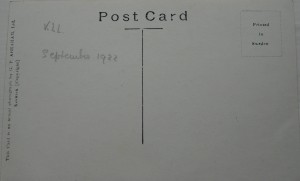By Lisa Smith, W&M Contributor
The ‘archival jolt’ happened in the strangest of places, a Brighton fleamarket. Idly rummaging through the detritus of people’s lives in search of treasure, I found a large box filled with used postcards, and I wondered who on earth would purchase such a useless thing. Of course, the snoop in me couldn’t resist a quick peek. I happily rooted through thank you notes, accounts of holidays, radio contest answers, and invitations, before finding some blank ones from the early twentieth century. These, at least, might be added to my stationary stash!
With disappointment I realised that several of the old postcards had, in fact, been ruined by small scrawled initials: ‘V.L.L.’ I scanned initialled card after initialled card, finding no truly blank ones. It was then that the jolt struck: who was this person? And what was the significance of this postcard collection?
Aided by my husband, who joined my quest, I amassed a large pile of initialled cards, all with dates from the 1920s. We had both been hooked by the mystery of V.L.L.’s cards. But thinking like a historian, I was at a loss to know how to analyse the essentially blank texts that provided no clues to the sex, name, or purpose of the collector.
My husband and I left the fleamarket, but all day our conversation returned to the postcards, as we imagined the story of V.L.L.’s cards, which were from all around Europe. Perhaps V.L.L. had been a former soldier or military nurse who had gotten a taste for travel while in service. Perhaps V.L.L. was merely an armchair traveller whose friends brought back pictures of their own trips. Or perhaps V.L.L. was a war widow, who took up a life of travel instead of remarriage. The fictive possibilities were endless, exhilarating.
The next morning found my husband and me in possession of a large garbage bag filled with five pounds of unsorted postcards, wondering how to get them back home.
And now that I know who buys used postcards, a bigger question remains: what am I going to do with them?
Lisa Smith is an Associate Professor of History at the University of Saskatchewan. She writes on gender, family, and health care in England and France (ca. 1600-1800), but has always had a soft spot for the early-twentieth century.

